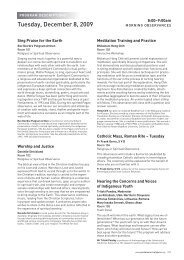Whispers and Vanities in Samoan Indigenous Religious Culture
Whispers and Vanities in Samoan Indigenous Religious Culture
Whispers and Vanities in Samoan Indigenous Religious Culture
Create successful ePaper yourself
Turn your PDF publications into a flip-book with our unique Google optimized e-Paper software.
The mov<strong>in</strong>g boat is meant to represent the man’s journey through life. As the boat<br />
moves along it hits a coral formation, metaphor for man com<strong>in</strong>g to a po<strong>in</strong>t where he<br />
wants to make a new life, i.e. create a child. The coral formation is therefore<br />
metaphor for the penis. The paddler at the end of the boat, the foe muli, then calls out:<br />
“taliu, taliu, ua to’a i le tu, ua mama le vaa” (“bailer, bailer, we struck a hard coral<br />
rock, the boat is leak<strong>in</strong>g”), at which po<strong>in</strong>t the boat becomes the vag<strong>in</strong>a. The<br />
performer play<strong>in</strong>g the bailer then comes away from the other performers <strong>and</strong> makes<br />
exaggerated bail<strong>in</strong>g actions us<strong>in</strong>g a coconut shell. His actions <strong>in</strong>clude ur<strong>in</strong>at<strong>in</strong>g <strong>in</strong>to<br />
the bailer/shell <strong>and</strong> spr<strong>in</strong>kl<strong>in</strong>g it over his fellow performers who share <strong>in</strong> the sacred<br />
belief underp<strong>in</strong>n<strong>in</strong>g the ritual. The ur<strong>in</strong>e is equated with sperm, the ultimate symbol<br />
of man’s power to procreate. The ‘sperm’ is thrown on people to make the po<strong>in</strong>t that<br />
we are all issues of sperm. To end the ritual the performers move to where the<br />
paramount chief sits, the highest rank issue of Tagaloa, <strong>and</strong> they flash him, mak<strong>in</strong>g<br />
the po<strong>in</strong>t: “no matter how highly ranked you are, <strong>in</strong> the ultimate we share the same<br />
orig<strong>in</strong>s <strong>and</strong> dest<strong>in</strong>y” 35 . After the flash<strong>in</strong>g there is celebration <strong>and</strong> the performers<br />
break <strong>in</strong>to dance. The dance is a celebration of human power <strong>and</strong> div<strong>in</strong>ity.<br />
The Salelesi auala vaa ritual is a solemn performance <strong>and</strong> <strong>in</strong> ancient times could not<br />
be performed by outsiders. It was performed at the break of dawn <strong>and</strong> people were<br />
forewarned to make sure that noth<strong>in</strong>g, especially children, would get <strong>in</strong> the way of the<br />
performers. The tapu surround<strong>in</strong>g the ritual was so strong that <strong>in</strong>terference with it<br />
could br<strong>in</strong>g about death.<br />
In the auala ritual the sacredness of the sex act is shown by the very formal way <strong>in</strong><br />
which the ceremony is carried out, from the movement towards the paramount chief<br />
to the mimick<strong>in</strong>g of the sex act to the ur<strong>in</strong>at<strong>in</strong>g <strong>in</strong> the coconut shell <strong>and</strong> then flash<strong>in</strong>g<br />
of the paramount chief on reach<strong>in</strong>g him. The conversation between the performers of<br />
the vaa ritual <strong>and</strong> the gods is deadly serious.<br />
In the Salani t<strong>in</strong>i there is still formal ceremony but the conversation between the<br />
performers <strong>and</strong> the gods is more playful. There is not the need for assert<strong>in</strong>g one’s<br />
div<strong>in</strong>ity <strong>in</strong> the same way. Rather, the aim is to lift the spirits of the couple <strong>in</strong><br />
preparation for their big night. The sa’ē on the other h<strong>and</strong>, has very little formal<br />
ceremony. The purpose of the dance is to openly flaunt one’s sexuality <strong>and</strong> if<br />
possible entice a sexual liaison <strong>and</strong> perhaps even a marriage union. In each of these<br />
events the body <strong>and</strong> its sexual organs while always tapu were not above be<strong>in</strong>g<br />
celebrated. Indeed, not to flaunt it would be considered the height of disrespect <strong>and</strong><br />
prudishness, both qualities to be discouraged if one sought the mana of the gods<br />
<strong>and</strong>/or the <strong>in</strong>terest of a desirable suitor.<br />
In the culture of tuumumusu there is connection between the story of the mat<strong>in</strong>g of the<br />
sun <strong>and</strong> a human woman, the rituals of welcom<strong>in</strong>g the naiufi as manaia, the<br />
traditional medic<strong>in</strong>al treatment of the laoa, <strong>and</strong> the ritual celebrations of the naked<br />
human body, its sexual organs <strong>and</strong> the sex act <strong>in</strong> funeral, marriage <strong>and</strong> poula<br />
ceremonies.<br />
35<br />
A common orig<strong>in</strong> <strong>in</strong> terms of a common genealogy <strong>and</strong> a common dest<strong>in</strong>y <strong>in</strong> terms of the fact<br />
that we will all return upon death to God Tagaloa.<br />
17











